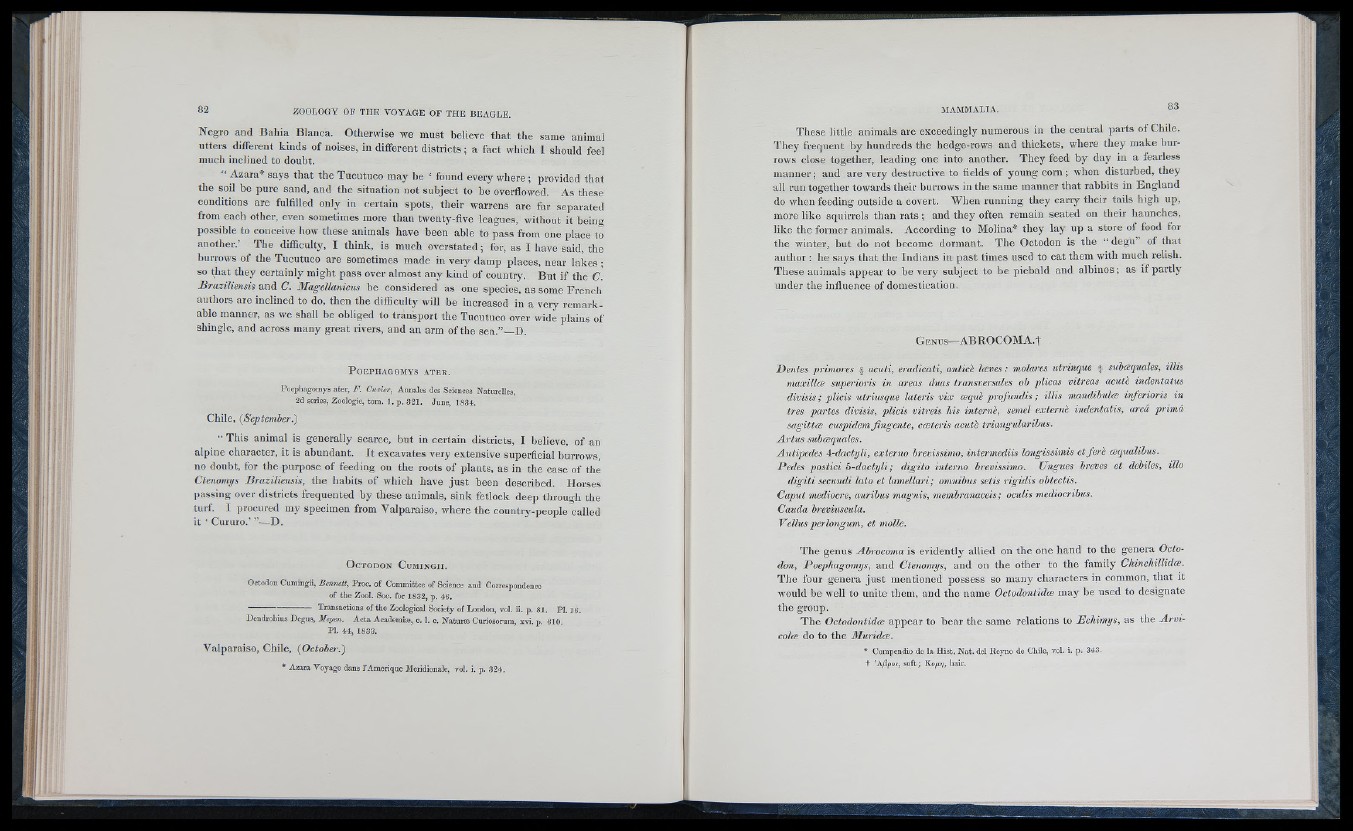
Negro and Bahia Blanca. Otherwise we must believe that the same animal
utters different kinds of noises, in different districts; a fact which I should feel
much inclined to doubt.
“ Azara* says that the Tucutuco may he ‘ found every where ; provided that
the soil be pure sand, and the situation not subject to be overflowed. As these
conditions are fulfilled only in certain spots, their warrens are far separated
from each other, even sometimes more than twenty-five leagues, without it being
possible to conceive how these animals have been able to pass from one place to
another.’ The difficulty, I think, is much overstated; for, as I have said, the
burrows of the Tucutuco are sometimes made iu very damp places, near lak es;
so that they certainly might pass over almost any kind of country. But if the C.
Braziliensis and C. Slagellanicns be considered as one species, as some French
authors are inclined to do, then the difficulty will be increased in a very remarkable
manner, as we shall he obliged to transport the Tucutuco over wide plains of
shingle, and across many great rivers, and an arm of the sea.” D.
POEPH.IGOMYS ATEE.
Poephagomya ater, P . C uder, A im ahs des Sciences Naturelles,
2d series, Zoologie, tom. 1 . p. 321. June, 1834.
Chile, (September.)
“ This animal is generally scarce, but in certain districts, I believe, of an
alpine character, it is abundant. It excavates very extensive superficial burrows,
no doubt, for the purpose of feeding on the roots of plants, as in the case of thé
Ctenomys Braziliensis, the habits of which have just been described. Horses
passing over districts frequented by these animals, sink fetlock deep through the
turf. I procured my specimen from Valparaiso, where the country-people called
it ‘ Ciiriiro.’ ”—D.
O c t o d o n C u m i n g i i .
Octodon Oumingii, B m m tt, Proc. ot Committee of Science and Oorrcjpondencc
of the Zool. Soc. for 1832, p. 46.
--------------------------Transactions of the Zoological Society of London, vol. ii. p. 81. PI. 16.
Dendrobius Degus, Meyen. A cta Academiaj, c. 1. c. N a tu re Curiosorum, xvi. p. 610.
PI. 44, 1833.
Valparaiso, Chile, (October.)
' Azara Voyage dans l’Amerique Meridionale, vol. i p. 324.
These little animals are exceedingly numerous in the central parts of Cliile.
They frequent by hundreds the hedge-rows and thickets, where they make burrows
close together, leading one into another. They feed by day in a fearless
manner ; and are very destructive to fields of young corn ; when disturbed, they
all run together towards their burrows in the same manner that rabbits in England
do when feeding outside a covert. When running they carry their tails high up,
more like squirrels than rats ; and they often remain seated on their haunches,
like the former animals. According to Molina* they lay up a store of food for
the winter, but do not become dormant. The Octodon is the “ degu” of that
author : he says that the Indians in past times used to eat them with much relish.
These animals appear to be very subject to be piebald and albinos; as if partly
under the influence of domestication.
G e n u s — ABROCOMA.i
Denies primores | acuti, eradicati, anticè loeves : molares utriuque ± suboequales, illis
maxilloe superioris in areas duas transversales oh plicas vitreas aculé indentatus
divisis ; pUcis utriusque lateris vix oequè profundis ; illis mandibuloe inferioris in
tres partes divisis, plicis vitreis his interné, semel externè indentatis, area prima
sagittoe cuspidem fingente, coeteris acutè triangularihus.
Artus suboequales.
Antipedes 4-dactyli, externo brevissimo, intermediis longissimis etferé oequalibus.
Pedes postici 5-dactyli; digito interno brevissimo. Ungues breves et debiles, ilio
digiti secundi lato et lamellari; omnibus setis rigidis obtectis.
Caput mediocre, auribus magnis, membranaceis ; oculis mediocrihus.
Cauda hreviuscula.
Vellus perlongum, et molle.
The genus Abrocoma is evidently allied on the one hand to the genera Octodon,
Poephagomys, and Ctenomys, and on the other to the family Chinchillidoe.
The four genera just mentioned possess so many characters in common, that it
would be well to unite them, and the name Octodontidm may be used to designate
the group.
The Octodontidoe appear to bear the same relations to Echimys, as the Aixi-
colce do to the 3Iuridoe.
* Compendio de la H ist, N at. del Rcyno de Chile, vol. i. p. 348.
t 'A/3poî, soft; Kopri, hair.